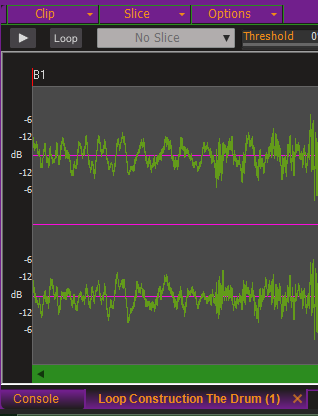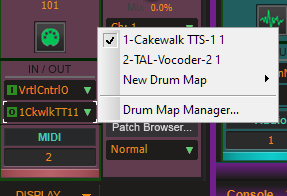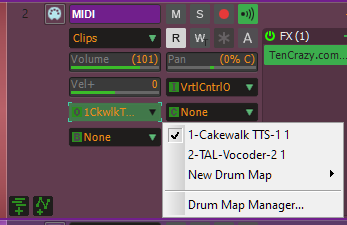-
Posts
8,666 -
Joined
-
Last visited
-
Days Won
30
Everything posted by Starship Krupa
-
Thanks for the heads-up on scanning from Preferences. I'm just clutching at straws at this point. Do you have any ideas as to what might actually be going on here, not being able to turn MIDI input on?
-
The instructions are from when I was using the VST2 version, but it's the same thing for the VST3 version. I am stumped, I don't know why it's not allowing you to enable MIDI input. One thing you can try is use Cakewalk Plug-In manager to force a re-scan of your plug-ins. It launches from the main Utilities menu. The button that triggers this is toward bottom center of the program's UI. It could be that Cakewalk somehow missed the fact that TAL Vocoder has MIDI input available.
-
There are some fantastic gems in the CM FX plug-in vault. Unfiltered Audio G8CM, the HY create-your-own multieffect, Boz-JST Sidewidener to name a few. I find the instruments to be less interesting. I think I prefer my synths either ROMpler or fairly straight ahead rather than learning a whole new paradigm, and theirs tend toward the latter. The ADM-CM drum machine is a notable exception. It's a Roland-alike that comes stock with 606 sounds, but each slot can be replaced with the excellent samples that CM includes. This CM Pluck thing works as bait to get people to install MSoundFactory, but by itself, I haven't found it very compelling. Maybe if they get some presets going. It's odd, Vojtech is arguably the industry leader in freebie enticements, seems like they could have done better with this.
-
This. If you like messing with DIY electronics, and you happen to get one with a decent capsule, there are drop-in circuit boards that will greatly improve the sound. If the capsule is krep, those can also be replaced. Nothing wrong with the body/housing as a mod platform. I've done the basic component mods (swapping film caps and aluminum electrolytics for ceramic and tantalum) on my inexpensive Chinese mics and the results were immediately audible and positive.
-

Plugin Boutique June Freebie - Presonus Fat Channel XT
Starship Krupa replied to cclarry's topic in Deals
I remember that. I enabled scan logging, and it was scanning it twice, once for the actual DLL and the second time for the folder. Wild guess: second time around it was marked as "not a DLL," which then kicked the earlier good scan out. I bet it will turn out that the only case is when the name of the DLL is the same as the name of a folder inside the VST3 folder. -
As much of a fan of both Meldaproduction and CM, this is coming off as kinda half-baked. The instructions in the magazine say that they will try to make some presets available at File Silo, but if they're up there, I can't find them. Also, the synth's main UI is 4 knobs and 4 horizontal sliders. The sliders are operated by placing your cursor on the knob and then dragging up and down. Note that I said "horizontal" sliders. If you try to drag left and right, nothing happens. Meldaproduction's patch browser is one of the company's weaker elements, and since MSoundFactory makes extensive use of browsing for instruments and patches, this is reflected in the product. I've yet to spend as much time lost in a softsynth's patch browser as I have with MSoundFactory, which is even weirder because the thing stock only comes with 2 instruments, the excellent grand piano and a really great-sounding synth called Super Saw. Word to the wise: once you finally get the UI of the instrument you want to show up, immediately make a DAW preset for the plug-in, before you touch or click on anything else. Failure to do so may result in your life ebbing away 5 minutes at a time while you repeatedly try to "get back" to where you last saw the piano or synth. What's that you say, you should be able to just search and find it? You are correct, you should. I'll let that one stand there. I tried the "download presets" button but it said I wasn't a licensed user, a condition that I am sure will prevail until such time as someone gives me the MCompleteBundle. An instrument is a different thing from an effect, and Meldaproduction's "Poindexter Jumps Down The Rabbit Hole" schtick works fine for the latter but not for the former.
-
The "output" option is supposed to be greyed out on an effect like TAL Vocoder that has no MIDI output. The only MIDI output you need be concerned with is the one of the MIDI track you're going to use to send MIDI data to the plug-in. So when you open the UI of the TAL Vocoder plug-in, and you click on the "VST2" button, you are unable to select "Enable MIDI Input" from the menu that appears? What should happen is that you pull the menu down, move your cursor to "Enable MIDI Input," then release. The menu will close. When you open the menu again, the menu should show "Enable MIDI Input" with a check mark. I know of no circumstances where that wouldn't work, not from a damaged Cakewalk installation nor anything wrong with the plug-in (if you can see the UI, the plug-in is installed correctly). There are only 3 steps in my instructions, it doesn't require any special knowledge, there's no easier vocoder option than this. It's not complicated or difficult once you know how to route it, which you get from the steps I wrote. After that, well, vocoders are kinda tricky to set all their levels up correctly, with the two different signals going in. But that's not the scope of what I wrote, I tell you how to install it correctly. Once you do that it's up to you to make sure that the audio on the track is good and that you're sending notes in the vocoder's appropriate range. Are the other plug-ins on your system in the same condition, or will they allow you to enable their MIDI input?
-

Plugin Boutique June Freebie - Presonus Fat Channel XT
Starship Krupa replied to cclarry's topic in Deals
I finally got Rubenesque Channel XT to show up in Cakewalk by removing the .VST3 suffix from the name of the folder it installs into under Program Files/Common Files/VST3. Also alerted both PreSonus and BandLab support about the issue. I have a feeling that in the end, Cakewalk should be able to scan even if it's in a folder named with the .VST3 suffix, but it's also kind of weird to have the installer create such a folder using that name instead of just naming it PreSonus or PresonusShell. It's like they're daring the host not to scan it correctly. Why make things harder? It's a nice multi-flavor, even more so after you go to PreSonus' site and pick up the extra 2 each compressors and EQ's. -
The Snake Oil guy is also into faceplate screws. I think there might be a few of those dressing up the front panel UI's. I got the T-Racks Model 670 from a freebie (Beat Magazine?) and yes, it is all that. It was the plug-in that introduced me to the spatial enhancement effects of applying different ratios and/or thresholds to mid and side. A technique I now use on every mix/master. There's an instance of it on at least one bus in everything I do (OH, drum, or master). So thanks to IK for these promos. I don't know how long it would have taken me, or if I would even have discovered it without my magazineware 670.
-

documentation Young Lady's Illustrated Primer to Theming Cakewalk
Starship Krupa replied to Colin Nicholls's topic in UI Themes
Got another color use ID: Time Ruler/Markers/Markers. Aside from the obvious one, it affects the color of the 0dB and channel divider lines in the Loop Construction View's waveform display. Behold the purpletration (the menu backgrounds are normally purple, it's EVA 01): -

Updating Cakewalk Plugins to VST3?
Starship Krupa replied to Moving Air Productions's topic in Feedback Loop
Who are "they?" If you are having problems combining VST2 and VST3 plug-ins in Cakewalk that is a bug, either in the plug-ins or in Cakewalk. If you're getting it in some other DAW, well, yet another reason to use Cakewalk. My experience is that I can mix VST2 and 3 with no issues, in both Cakewalk and Mixcraft. It doesn't even get a second thought. When installing plug-ins, I now go with VST3 when it's available, but see no real advantage to this practice. One thing I will say, there is more than one plug-in I have where the VST3 version doesn't work but the VST2 version does. Your reason 2 and....other reason 2 are both things that Craig's article listed as "myths." Cakewalk still supports DXi and is highly unlikely to drop support for VST2, especially considering how all of their bundled plug-ins are in VST2 (or DXi format). Ableton didn't even support it until 10.1. Dropping support for VST2 plug-ins any time in the foreseeable future would be a suicide move for any DAW. Most of them at this point even support 32-bit plug-ins, which I find slightly odd, but why force people to ditch software that they probably paid a lot of money for? Yes, the VST3 spec expands on the available features. Most of those features had already been included by plug-in manufacturers' implementation of VST2. (sidechaining, resizable UI's: little-known fact, the VST2.4 spec includes resizable UI's)The one biggie, the ability to go dormant when they're not processing audio, is a feature that I have seen exactly one developer implement, Meldaproduction. And he only implemented it last year. This is after 12 years of the VST3 spec being the standard. One single developer (other than, perhaps Steinberg) has implemented the feature that, to me, is the only really useful one. Craig's article is excellent and thorough and I agree with every point he makes. I also have to wonder whether some of the "myth" trash talk he mentions came from my forum posts, as I have had a loud mouth about knocking VST3. Since the Meldaproduction implementation (I own 57 of their plug-ins, so this is pretty huge) I have backed off a bit, but I still think that VST3 is the "New Coke" of plug-in standards. It could have been a lot better, could have implemented lots of things like multiple instances of a plug-in sharing the same kernel, the ability for the plug-in and the host to share patch info, integration with control surfaces, improved error handling, inter-plug-in communication, etc. What if there were easier ways for plug-ins from different manufacturers to communicate with each other, like being able to sync LFO rates and delay times without locking them to the project tempo? I would LOVE such a feature. All of that could have been put in the spec. I tend to rant about this subject because it bothers me. I've had a lot of experience with crashy VST3's, my former main DAW, Mixcraft, only got their support working in the most recent release. Before that, I avoided VST3's like the plague. Yes, the issue was with their implementation, but what was it that forced them to have to do that? The plug-ins I would love to see get aesthetic makeovers are the Sonitus fx. An update to VST, scalable more "2020's" interfaces. I think they sound great, I just don't use them because the UI's are too tiny for my eyes. The Cakewalk Creative set, not so much, too much good freeware will do what they do. -
A classic clipper.
-

Plugin Boutique June Freebie - Presonus Fat Channel XT
Starship Krupa replied to cclarry's topic in Deals
I'd really like to be able to try out Big Beautiful Channel in Cakewalk, especially since I also picked up the free add-on pack with another 4 processors. A weird thing is that it shows up on neither of my systems, yet on both it loads just fine in Mixcraft. I've forced rescanning of all my plug-ins in Plug-In Manager (including failed), looked for excluded ones, nothing to be found. There's nothing in there that's not covered by MTurboEQ and MTurboComple (and of course ProChannel), both of which I have, but I always learn something when test-driving FX. -
You should be setting the output of the MIDI track to the plug-in. This will appear as an available output once you do my Step 3, as shown in Steve's graphic. From your screenshot, it seems you may have some confusion as to how to set the output of a MIDI track. Down at the bottom of the MIDI strip (Console or Inspector): Or from the Track View Track Header:
-

Plugin Boutique June Freebie - Presonus Fat Channel XT
Starship Krupa replied to cclarry's topic in Deals
I'm going to take this as a "no." I guess I'll contact PreSonus support about it. -

Editable Elements > Tabs > Inspector > Audio & MIDI tabs
Starship Krupa replied to user905133's topic in UI Themes
Thanks for reminding me. I need to visit these images in EVA 01. I missed it due to being a mostly split instrument guy. -
Interesting. What interface do you have that has an ASIO driver with a shared mode? The ones I've seen only allow one app at a time to use the ASIO driver, although I find I can still run other apps in WASAPI with varying results.
-
Is there anyone this hasn't bitten? One of the best features in the BandLab era is that Ripple Edit indicator, and even with that, I've futzed it up a time or two.
-
Scenario: I've just played piano for 5 minutes on my MIDI controller into Cakewalk. I play back what I just did and there's a nasty clinker where my thumb hit the wrong key at one of the chord changes. I hit M to drop a marker at that location for later cleaning, then stop the transport. I open the Piano Roll and it's centered on notes 4 minutes earlier in the timeline. I of course want to get to the one where I placed the marker, as fast as possible. What do I do? I can (dis)engage Scroll Lock, which will make Cakewalk to center on the playback cursor and then send the cursor to the marker using the Markers module in Control Bar. Is marker navigation something that I need to go back to the Track View to work with (unless I'm going prev/next with a keystroke)? No way directly from PRV? Better way to do this? I spend more time than I'd like scrolling up and down and back and forth in PRV trying to find the note(s) I want to edit.
-

Updating Cakewalk Plugins to VST3?
Starship Krupa replied to Moving Air Productions's topic in Feedback Loop
What would be the benefit(s) of having those plug-ins in VST3 format rather than VST2? What changes do you think would get them "up to today's standards?" I personally think that they work pretty well as they are, including the UI's. BTW, the Feedback section is a better place for suggestions. -
Are you trying to use BandLab, the browser-based DAW, or Cakewalk by BandLab, the one that runs natively in Windows? If you're talking about BandLab, this is not in the right place to try to get help on it. This forum is for Cakewalk.
-
And when vertical real estate is tight is when I notice how much useless space there is at the top of the hardware output strips. I use them sometimes, to equalize volume between my 4 monitor systems. One feature I find most amusing is the way you can widen/narrow the hardware strips down to the width of a normal bus or track strip. I sleep better at night knowing that that extra bit of width is there on my hardware outputs if I decide I need it, and conversely, if I want to run lean 'n' mean, I can shrink them. Still, the fact that they all change width at the same time means that it could be made even more versatile, more customizable.
-
So his lead tone. Yes, I'd say that an emulation of a transistor fuzz like a Fuzz Face and tune it as necessary with EQ. Go ahead and build one! It's fun.
-

Plugin Boutique June Freebie - Presonus Fat Channel XT
Starship Krupa replied to cclarry's topic in Deals
Has anyone who doesn't also have Studio One gotten this to work in Cakewalk? I installed the Hub, jumped through all the hoops, Cakewalk says it's scanning the PreSonus VST3 shell, but it doesn't appear anywhere, not in the Browser or Plug-In Manager. I'd really like to have it around, because it works in Mixcraft so I saw what it can do. Packing a lot of stuff in this plug-in. Pultec-style, 4+2 parametric, and channel-style EQ's, 1176, LA-2A, and precision compressors, gate, limiter. It's a regular Swiss Army knife. Frigger won't show up in Cakewalk, though....







